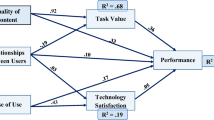Abstract
This empirical study used Keller’s (Technol Instr Cogn Learn 16:79–104, 2008b) motivation, volition, and performance (MVP) theory to develop and statistically evaluate a mathematical MVP model that can serve as a research and policy tool for evaluating students’ learning experiences in digital environments. Specifically, it explored undergraduate biology students’ learning and attitudes toward e-texts using a MVP mathematical model in two different e-text environments. A data set (N = 1334) that included student motivation and e-text information processing, frustration with using e-texts, and student ability variables was used to evaluate e-text satisfaction. A regression analysis of these variables revealed a significant model that explained 77% of the variation in student e-text satisfaction in both e-text learning environments. Student motivation and intrinsic cognitive load were positive predictors of student satisfaction, while extraneous cognitive load and student prior knowledge and background variables were negative predictors. Practical implications for e-text learning and generalizability of a mathematical MVP model are discussed.



Similar content being viewed by others
References
Ackerman, R., & Lauterman, T. (2012). Taking reading comprehension exams on screen or on paper? A metacognitive analysis of learning texts under time pressure. Computers in Human Behavior, 28, 1816–1828.
Anderson, A. K. (2014). Use of admissions data to predict student success in postsecondary freshman science. (PhD Dissertation), Capella University.
Apple, I. (2015). Not just reading—Interacting: The textbook transformation. Retrieved from https://www.apple.com/education/ipad/ibooks-textbooks/.
Atkinson, R. C., & Schiffrin, R. M. (1971). The control of short-term memory. Scientific American, 225, 82–90.
Biermann, C. A., & Sarinsky, G. B. (1989). Selected factors associated with achievement of biology preparatory students and their follow-up to higher level biology courses. Journal of Research in Science Teaching, 26(7), 575–586.
Boland, L. A. (2014). Model building in economics: Its purposes and limitations. New York, NY: Cambridge University Press.
Boroughs, D. (2010). Bye the book: In educational publishing the only certainty is change. PRISM 19. Retrieved from http://www.prism-magazine.org/apr10/feature_01.cfm.
Ceaparu, I., Lazar, J., Bessiere, K., Robinson, J., & Shneiderman, B. (2004). Determining causes and severity of end-user frustration. International Journal of Human-Computer Interaction, 17(3), 333–356.
Dabbaghian, V., & Mago, V. K. (2014). Theories and simulations of complex social systems. Berlin: Springer.
Deci, E. L., & Ryan, R. (1985). Intrinsic motivation and self-determination in human behavior. New York: Plenum.
Deng, L., Turner, D. E., Gehling, R., & Prince, B. (2010). User experience, satisfaction, and continual usage intention of IT. European Journal of Information Systems, 19(1), 60–75.
Dennis, A. (2011). e-Textbooks at Indiana University: A summary of two years of research. Bloomington, IN: Indiana University.
Festinger, L. (1957). A theory of cognitive dissonance. Stanford, CA: Stanford University Press.
Field, A. (2013). Discovering statistics using IBM SPSS statistics. (4th ed.). London: Sage.
Fletcher, G., Schaffhauser, D., & Levin, D. (2012). Out of print: Reimagining the K-12 textbook in a digital age. Paper presented at the State Educational Technology Directors Association (SETDA), Washington, DC.
Gollwitzer, P. M. (1999). Implementation intentions. Strong effects of simple plans. American Psychologist, 54(7), 493–503.
Hao, Y. (2016). Exploring undergraduates’ perspectives and flipped learning readiness in their flipped classrooms. Computers in Human Behavior, 59, 82–92.
Heider, R. (1958). The psychology of interpersonal relations. New York: Wiley.
Huang, W., Huang, W., Diefes-Dux, H., & Imbrie, P. K. (2006). A preliminary validation of attention, relevance, confidence and satisfaction model-based instructional material motivational survey in a computer-based tutorial setting. British Journal of Educational Technology, 37(2), 243–259.
Huang, W.-H., Huang, W.-Y., & Tschopp, J. (2010). Sustaining iterative game playing processes in DGBL: The relationship between motivational processing and outcome processing. Computers & Education, 55(2), 789–797.
Hummon, N. P., & Doreian, P. (2003). Some dynamics of social balance processes: Bringing Heider back into balance theory. Social Networks, 25(1), 17–49.
Hung, M. L., Chou, C., Chen, C. H., & Own, Z. Y. (2010). Learner readiness for online learning: Scale development and student perceptions. Computers & Education, 55(3), 1080–1090.
Hyman, J. A., Moser, M. T., & Segala, L. N. (2014). Electronic reading and digital library technologies: Understanding learner expectation and usage intent for mobile learning. Educational Technology Research and Development, 63, 35–52.
Kang, Y. S., & Lee, H. (2010). Understanding the role of an IT artifact in online service continuance: An extended perspective of user satisfaction. Computers in Human Behavior, 26(3), 353–364.
Keller, J. M. (1987a). Development and use of the ARCS model of motivational design. Journal of Instructional Development, 10(3), 2–10.
Keller, J. M. (1987b). Strategies for stimulating the motivation to learn. Performance and Instruction, 26(8), 1–7.
Keller, J. M. (1993). Motivation by design. Tallahassee, Florida: Florida State University.
Keller, J. M. (1999). Using the ARCS motivational process in computer-based instruction and distance education. New Directions for Teaching and Learning, 78, 39–48.
Keller, J. M. (2008a). First principles of motivation to learn and e3-learning. Distance Education, 29(2), 175–185.
Keller, J. M. (2008b). An integrative theory of motivation, volition, and performance. Technology, Instruction, Cognition and Learning, 16, 79–104.
Keller, J. M. (2010). Motivational design for learning and performance: The ARCS model approach. New York: Springer.
Kuhl, J. (1987). Action control: The maintenance of motivational states. In F. Halisch & J. Kuhl (Eds.), Motivation, intention and volition (pp. 279–291). Berlin: Springer.
Lamb, A. (2001). Reading redefined for a transmedia universe. Learning & Leading with Technology, 39(3), 12–17.
Le Bigot, L., & Rouet, J. F. (2007). The impact of presentation format, task assignment, and prior knowledge on students’ comprehension of multiple online documents. Journal of Literacy Research, 39(4), 445–470.
Leppink, J., Paas, F., Van der Vleuten, C. P. M., Van Gog, T., & Van Merriënboer, J. J. G. (2013). Development of an instrument for measuring different types of cognitive load. Behavior Research Methods, 45(4), 1058–1072.
Leppink, J., Paas, F., van Gog, T., van der Vleuten, C. P. M., & van Merriënboer, J. J. G. (2014). Effects of pairs of problems and examples on task performance and different types of cognitive load. Learning and Instruction, 30, 32–42.
Liu, Z. (2005). Reading behavior in the digital environment: Changes in reading behavior over the past ten years. Journal of Documentation, 61(6), 700–712.
Loorbach, N., Peters, O., Karreman, J., & Steehouder, M. (2015). Validation of the instructional materials motivation survey (IMMS) in a self-directed instructional setting aimed at working with technology. British Journal of Educational Technology, 46(1), 204–218.
Mayer, R. E. (2001). Multimedia learning. Cambridge: Cambridge University Press.
Novak, E. (2014). Toward a mathematical model of motivation, volition, and performance. Computers & Education, 74, 73–80. https://doi.org/10.1016/j.compedu.2014.01.009.
Novak, E., Daday, J., & McDaniel, K. (2018). Assessing intrinsic and extraneous complexity of e-text learning. Interacting with Computers, 30(2), 150–161. https://doi.org/10.1016/j.compedu.2014.01.009.
Oliver, R. L. (1977). Effect of expectation and disconfirmation on postexposure product evaluations: An alternative interpretation. Journal of Applied Psychology, 62(4), 480–486.
Oliver, R. L. (1980). A cognitive model of the antecedents and consequences of satisfaction decisions. Journal of Marketing Research, 17(4), 460–469.
Paas, F., Renkl, A., & Sweller, J. (2003). Cognitive load theory and instructional design: Recent developments. Educational Psychologist, 38(1), 1–4.
Pearl, J. (2000). Causality: Models, reasoning, and inference. Cambridge, England: Cambridge University Press.
Pfaffl, M. W. (2001). A new mathematical model for relative quantification in real-time RT–PCR. Nucleic Acids Research, 29(9), e45–e45.
Piccoli, G., Ahmad, R., & Ives, B. (2001). Web-based virtual learning environments: a research framework and a preliminary assessment of effectiveness in basic IT skill training. MIS Quarterly, 25(4), 401–426.
Rockinson- Szapkiw, A. J., Courduff, J., Carter, K., & Bennett, D. (2013). Electronic versus traditional print textbooks: A comparison study on the influence of university students’ learning. Computers & Education, 63, 259–266.
Rodgers, J. L. (2010). The epistemology of mathematical and statistical modeling: A quiet methodological revolution. American Psychologist, 65(1), 1–12.
Selvidge, P. R., Chaparro, B. S., & Bender, G. T. (2002). The world wide wait: Effects of delays on user performance. International Journal of Industrial Ergonomics, 29, 15–20.
Sepehr, S., & Head, M. (2017). Understanding the role of competition in video gameplay satisfaction. Information & Management. https://doi.org/10.1016/j.im.2017.09.007
Shepperd, J. A., Grace, J. L., & Koch, E. J. (2008). Evaluating the electronic textbook: Is it time to dispense with the paper text? Teaching of Psychology, 35, 2–5.
Sun, P.-C., Tsai, R. J., Finger, G., Chen, Y.-Y., & Yeh, D. (2008). What drives a successful e-Learning? An empirical investigation of the critical factors influencing learner satisfaction. Computers & Education, 50(4), 1183–1202.
Sweller, J. (2010). Element interactivity and intrinsic, extraneous and germane cognitive load. Educational Psychology Review, 22, 123–138.
Sweller, J., & Chandler, P. (1994). Why some material is difficult to learn. Cognition and Instruction, 12, 185–223.
Tamura, K., Masatoshi, N., & Sudhir, K. (2004). Prospects for inferring very large phylogenies by using the neighbor-joining method. Paper presented at the Proceedings of the National Academy of Sciences of the United States of America.
Thomas, A. (2013). A study of algebra 1 students’ use of digital and print textbooks. (PhD Dissertation), University of Missouri-Columbia.
Van Merriënboer, J. J. G., & Sweller, J. (2005). Cognitive load theory and complex learning: Recent developments and future directions. Educational Psychology Review, 17, 147–177.
Weisberg, M. (2011). Student attitudes and behaviors towards digital textbooks. Publishing Research Quarterly, 27(2), 188–196.
Wigfield, A., & Eccles, J. S. (2000). Expectancy-value theory of achievement motivation. Contemporary Educational Psychology, 25(1), 68–81.
Woody, W. D., Daniel, D. B., & Baker, C. A. (2010). E-books or textbooks: Students prefer textbooks. Computers & Education, 55, 945–948.
Yilmaz, R. (2017). Exploring the role of e-learning readiness on student satisfaction and motivation in flipped classroom. Computers in Human Behavior, 70(Supplement C), 251–260. https://doi.org/10.1016/j.chb.2016.12.085
Zimmerman, B. J. (2001). Theories of self-regulated learning and academic achievement: An overview and analysis. In B. J. Zimmerman & D. H. Schunk (Eds.), Self-regulated learning and academic achievement. Theoretical perspectives (pp. 1–38). Erlbaum, NJ: Mahwah.
Funding
This research was funded by Western Kentucky University (WKU) Division of Extended Learning and Outreach’s (DELO) Online Learning Research Office.
Author information
Authors and Affiliations
Corresponding author
Ethics declarations
Conflict of interest
The authors declare that they have no conflict of interest.
Rights and permissions
About this article
Cite this article
Novak, E., Daday, J. & McDaniel, K. Using a mathematical model of motivation, volition, and performance to examine students’ e-text learning experiences. Education Tech Research Dev 66, 1189–1209 (2018). https://doi.org/10.1007/s11423-018-9599-5
Published:
Issue Date:
DOI: https://doi.org/10.1007/s11423-018-9599-5




